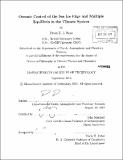Oceanic control of the sea ice edge and multiple equilibria in the climate system
Author(s)
Rose, Brian E. J. (Brian Edward James)
DownloadFull printable version (26.06Mb)
Other Contributors
Massachusetts Institute of Technology. Dept. of Earth, Atmospheric, and Planetary Sciences.
Advisor
John Marshall.
Terms of use
Metadata
Show full item recordAbstract
I study fundamental mechanisms of atmosphere-ocean-sea ice interaction. Hierarchies of idealized models are invoked to argue that multiple equilibria and abrupt change are robust features of the climate system. The main finding is that meridional structure in poleward oceanic energy transport, which is set by the wind forcing, gives rise to preferred latitudes for the sea ice edge, including a stable large ice cap extending into mid-latitudes. I review multiple equilibria in energy balance models (EBMs), and extend the EBM to include explicit ocean heat transport (OHT) and insulating sea ice. I derive a method for simultaneously satisfying global energy and angular momentum budgets through a diffusive closure for potential vorticity, enabling a prediction of the basic shape of the surface wind stress. An idealized model of wind-driven gyres links this stress to OHT, and gives significant structure on sub-hemispheric scales in agreement with observations. This model predicts a stable large ice cap solution not found in the classic EBM, made possible by convergence of OHT in mid-latitudes. Analogous multiple equilibria are found in coupled atmosphere-ocean-sea ice general circulation model (GCM) simulations with idealized geometry (a pure aquaplanet and a "ridgeworld" with a global-scale ocean basin). Despite differing ocean dynamics, both configurations support similar equilibria: an ice-free climate, a cold climate with mid-latitude sea ice edge, and a completely ice-covered Snowball state. Multiple states persist despite a seasonal cycle and vigorous internal variability. Simulations with slowly-evolving thermal forcing show that some transitions between the ice-free and large ice cap states are abrupt. Multiple equilibria are explored in uncoupled simulations with prescribed OHT. The large ice cap is stabilized by wind-driven convergence of OHT at the poleward edge of the subtropical thermocline. The size of the large ice cap is sensitive to the meridional and seasonal distribution of OHT convergence. The ice-free state persists in the absence of high-latitude OHT. Mid-latitude convergence of OHT warms the poles by driving increased atmospheric heat transport to the poles. This effect is captured in a simple diffusive EBM. I discuss the significance of these findings for understanding the paleoclimate record.
Description
Thesis (Ph. D.)--Massachusetts Institute of Technology, Dept. of Earth, Atmospheric, and Planetary Sciences, 2010. Cataloged from PDF version of thesis. Includes bibliographical references (p. 215-227).
Date issued
2010Department
Massachusetts Institute of Technology. Department of Earth, Atmospheric, and Planetary SciencesPublisher
Massachusetts Institute of Technology
Keywords
Earth, Atmospheric, and Planetary Sciences.